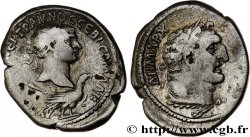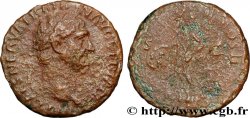brm_1033295 - TRAJANUS Denier
250.00 €
Количество
Добавить в корзину

Тип Denier
Дата: 105
Монетный двор / Город: Roma
Металл: silver
Проба: 900 ‰
Диаметр: 18,5 mm
Ориентация осей монеты: 6 h.
Вес: 3,37 g.
Редкость: R1
Officine: 1re
Комментарии о состоянии
Monnaie idéalement centrée. Superbe buste ainsi qu’un revers de style fin. Patine grise
Ссылки в каталоге: :
Лицевая сторона
Аверс: легенда: IMP TRAIANO AVG GER DAC P M TR P COS V P P.
Аверс: описание: Buste lauré de Trajan à droite, avec l’égide sur l’épaule gauche (O*4).
Аверс: перевод: “Imperatori Traiano Augusto Germanico Dacico Pontifex Maximus Tribunicia Potestate Consuli quinto, Patri Patriæ”, (À l’empereur Trajan auguste germanique, dacique, grand pontife, revêtu de la puissance tribunitienne, consul pour la cinquième fois, père de la patrie).
Обратная сторона
Реверс: легенда: S P Q R OPTIMO PRINCIPI.
Реверс: Описание: Fortuna (la Fortune) drapée assise à gauche, tenant un gouvernail de la main droite et une corne d’abondance de la main gauche.
Реверс: перевод: “Senatus Populus Que Romanus Optimo Principi”, (Le sénat et le peuple romain, au meilleur des princes).
Комментарий
Rubans de type 1. Il revient à l’école anglaise et aux travaux de P. V. Hill, The dating and arrangement of the Undated Coins of Rome AD. 98-148, Londres 1970, d’avoir reclassé les différentes émissions de l’atelier de Rome, grâce à la théorie des cycles et d’avoir mis en lumière l’organisation de l’atelier de Rome qui travaille en officines et non pas en fonction du métal comme l’avaient décrit les numismates du XIXe siècle.
Ribbons of type 1. It is due to the English school and the work of PV Hill, The dating and arrangement of the Undated Coins of Rome AD. 98-148, London 1970, to have reclassified the different issues of the mint of Rome, thanks to the theory of cycles and to have highlighted the organization of the mint of Rome which works in workshops and not according to the metal as the numismatists of the 19th century had described it.
Ribbons of type 1. It is due to the English school and the work of PV Hill, The dating and arrangement of the Undated Coins of Rome AD. 98-148, London 1970, to have reclassified the different issues of the mint of Rome, thanks to the theory of cycles and to have highlighted the organization of the mint of Rome which works in workshops and not according to the metal as the numismatists of the 19th century had described it.








 Cообщить об ошибке
Cообщить об ошибке Распечатать страницу
Распечатать страницу Отправить мой выбор
Отправить мой выбор Задать вопрос
Задать вопрос Consign / sell
Consign / sell
 Информация
Информация










